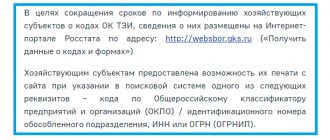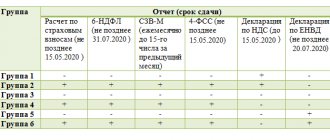October 12, 2021 In continuation of the answers to questions about submitting reports for 9 months of 2021, we invite you to read in more detail the explanations on questions 1 and 2, in particular, on submitting monthly reports to the Pension Fund of the Russian Federation - form SZV-M.
In continuation of the answers to questions on submitting reports for 9 months of 2021, we suggest that you familiarize yourself in more detail with the explanations on questions 1 and 2, in particular, on submitting monthly reports to the Pension Fund of the Russian Federation - form SZV-M.
Commentary provided by certified tax consultant Emma Forstreter.
Property tax returns
For 2021, organizations submit a new property tax declaration form (Federal Tax Service order No. SA-7-21 dated August 14, 2019/ [email protected] ). Now property reporting is annual. It is no longer necessary to send quarterly advance payments to tax authorities. But this does not cancel the payment of advance payments. They need to be calculated and listed in the same order, and then reflected in the declaration for the year.
See what's changing in how property tax advances are calculated starting in 2021.
As for declarations on transport and land taxes, their forms for 2021 have not changed. But this will be the last time we hand them over. Starting with taxes for 2021, their declaration is canceled.
See here for details.
SZV-experience: new reporting to the Pension Fund for all employers
Employers will submit this report for the first time in 2021.
The SZV-experience together with the EDV-1 application is submitted once a year, before March 1. It does not matter whether any payments were made to the employees.
Like other reports for employers, work experience can only be submitted electronically if information is submitted for 25 or more people.
A new form must be submitted separately when an employee retires.
We talked in more detail about the new report in this material.
table 2
This section of the report includes the calculation of the contributions payable:
- Page 1 reflects the employer’s debt on contributions as of 01/01/2018. This value can be taken from page 19 of the table. 2 forms 4-FSS for 2021. In all 4 reports this value remains unchanged.
- Page 1.1 is filled out in the case when the report is submitted by the legal successor or the data is presented according to a separate entity that has already been deregistered.
- Page 2 reflects a lot of data, but they are all mathematically related. The total amount in the 3rd column is obtained by adding the lines “At the beginning of the reporting period” and “For the last three months”, which in turn will be the sum of the next three lines - 1, 2 and 3 months.
- Page 3 shows whether contributions were accrued as a result of the audit.
- Page 4 reflects the amount not accepted by the Social Insurance Fund for offset.
- Page 5 shows the amounts additionally accrued by the policyholder independently for past periods.
- Page 6 reflects the amount of reimbursement of the policyholder’s expenses received from the Fund.
- Page 7 shows the return of overpaid or collected contributions.
- Page 8 shows the total of pages 1 to 7.
- Page 9-11 reflect the amount of debt owed by the division of the Federal Social Insurance Fund of the Russian Federation at the end of the period:
- page 9 - total amount;
- p. 10 – including due to excess costs;
- p.11 – including due to overpayment.
- Pages 12-14 reflect the amount of debt owed to the division of the Federal Social Insurance Fund of the Russian Federation at the beginning of the period:
- p. 12 - the total amount, its indicator must correspond to p. 9 of the 4-FSS report for 2021.
- p.13 – including due to excess costs;
- page 14 – including due to overpayment.
- Page 14.1 contains information about the debt of a fund division to a successor or a liquidated separate division.
- Page 15 reflects the company's expenses related to insurance of personal insurance and occupational diseases. Amounts are indicated for the entire reporting period and for 3 months of the reporting period.
- Page 16 contains information about insurance premiums actually paid. They are also shown for the period as a whole and monthly for the last three months; payment dates and payment order numbers are also indicated.
- Page 17 reflects information about the written off debt of the policyholder.
- Page 18, similar to page 8, is a control. It contains the sum of the values on pages 12 to 17.
- Page 19 reflects the debt owed by the policyholder at the end of the reporting period. The arrears (if any) are highlighted on page 20.
How have the 2019-2020 salary tax reporting forms changed?
Salary reporting submitted to the tax authorities includes:
- 2-NDFL certificates;
- calculation of 6-NDFL;
- calculation of insurance premiums.
The forms of these reports for submission for 2021 remain the same, but the order of their presentation has changed significantly. And these changes cannot be missed, otherwise fines are possible.
Firstly, the deadline for submitting 2-NDFL information and calculating 6-NDFL at the end of the year has been reduced. Now it is March 1, and not April 1, as it was before. In 2020 it is Sunday, so the deadline will be 03/02/2020.
Secondly, fewer employers still have access to the paper version of reporting. Employers with up to 10 employees can report on paper (previously there were up to 25 “physicists”). This applies not only to 2-NDFL and 6-NDFL, but also to the calculation of contributions.
We wrote more about this here.
In addition, from 2021 there are changes in salary reporting for organizations with divisions.
The ERSV form will also change in the near future. A new form is being introduced with reporting for the 1st quarter of 2021 (Federal Tax Service order dated September 18, 2019 No. ММВ-7-11/ [email protected] ).
Table 3
This part of the report is filled out by those policyholders who independently incur expenses for insurance against accidents and occupational diseases. Columns 3 and 4 reflect the number of paid days (where applicable) and the payment amount. Types of expenses are listed by line:
- Page 1 and 4 - payments of benefits for temporary disability in connection with emergency situations at work and occupational diseases.
- On pages 2, 3, 5, 6 from lines 1 and 4, payments are allocated to external part-time workers and victims in another organization.
- Page 7 reflects the costs of paying for additional admission for sanatorium-resort treatment.
- On page 8 from page 7, the costs of vacation pay for employees who suffered in another organization are allocated.
- Page 9 reflects payment for preventive measures to reduce injuries and occupational diseases.
- Page 10 summarizes all types of expenses. It is the sum of pages 1, 4, 7, 9.
- Page 11 provides information about benefits not paid as of the reporting date. If at the time of filing the benefit report the payment period has not yet expired, then they are not included in this line.
Table 1.1
It is filled out only by those policyholders who send their employees to work for another employer.
- Columns 2, 3, 4 reflect general information about the organization where the employees were sent (FSS, INN and OKVED codes).
- Column 5 shows the total number of such employees.
- Columns 6–13 determine the basis for calculating insurance premiums. As in table. 1, payments are broken down according to 4 criteria: cumulatively from the beginning of the year and broken down by months of the reporting period. From each value, payments in favor of disabled people are allocated.
- Columns 14 and 15 show the size of the insurance tariff of the receiving organization.




